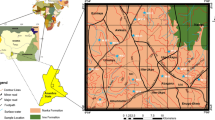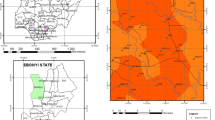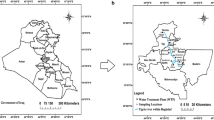Abstract
Damodar River has been polluted due to human activities and the discharge of domestic and industrial wastewater. It is a possible source of water for nearby areas to meet the requirements. Therefore, the purpose of the research is to provide a clear representation of river water quality using different water quality indices together. To determine the class of water of this river, concentrations of 17 physico-chemical parameters have been compared with the standard limits prescribed by various organizations. These indicate that BOD, TC, and turbidity concentrations are high, and river water is fresh and moderately hard. Three indices like weighted arithmetic water quality index (WAWQI), Canadian Councils WQI (CCME-WQI), and comprehensive pollution index (CPI) are used together to determine the class of water with a higher level of confidence. To minimize the cost of parameter analysis, six parameters were eliminated using Pearson’s correlation, and 11 parameters have been used to calculate three indices. Index scores with TC obtained by WAWQI, CCME-WQI, and CPI indicate unfit for drinking, poor category, and highly polluted water in this river, while three index scores without TC indicate fair to very poor water with slight pollution. To obtain water quality for every indicator, an in-depth analysis of rating scale estimates has been newly introduced because of the dissimilarity between the classification schemes of the applied methodologies. Final results and overall analysis confirm that the water is not suitable to drink. Water quality can be improved by TC control, and treatment is necessary before human consumption.






Similar content being viewed by others
Data Availability
All data analyzed during this study are included in this article.
References
Akoteyon, I. S., Omotayo, A. O., Soladoye, O., & Olaoye, H. O. (2011). Determination of water quality index and suitability of urban river for municipal water supply in Lagos-Nigeria. European Journal of Scientific Research, 54(2), 263–271.
Ali, S. Y., Sunar, S., Saha, P., Mukherjee, P., Saha, S., & Dutta, S. (2021). Drinking water quality assessment of river Ganga in West Bengal, India through integrated statistical and GIS techniques. Water Science Technology, 84(10–11), 2997–3017. https://doi.org/10.2166/wst.2021.293
Annapoorna, H., & Janardhana, R. M. (2015). Assessment of groundwater quality for drinking purpose in rural areas surrounding a defunct copper mine. Aquatic Procedia, 4, 685–692. https://doi.org/10.1016/j.aqpro.2015.02.088
APHA. (2005). Standard methods for the examination of water and wastewater (21st ed.). American Public Health Association.
Banerjee, S. U., & Gupta, S. (2013). Impact of industrial waste effluents on river Damodar adjacent to Durgapur industrial complex, West Bengal, India. Environmental Monitoring and Assessment, 185, 2083–2094. https://doi.org/10.1007/s10661-012-2690-1
Bărbulescu, A., & Barbeş, L. (2020). Assessing the water quality of the Danube River (at Chiciu, Romania) by statistical methods. Environmental Earth Sciences, 79, 122. https://doi.org/10.1007/s12665-020-8872-1
Basu, S., & Lokesh, K. S. (2021). Assessment of river water quality using weighted arithmetic water quality index in the River Kabini at Nanjangud, Karnataka. India. Applied Ecology and Environmental Sciences, 9(11), 914–918.
Bhutiani, R., Khanna, D. R., Kulkarni, D. B., & Ruhela, M. (2016). Assessment of Ganga river ecosystem at Haridwar, Uttarakhand, India with reference to water quality indices. Applied Water Science, 6, 107–113. https://doi.org/10.1007/s13201-014-0206-6
Bora, M., & Goswami, D. C. (2016). Water quality assessment in terms of water quality index (WQI): Case study of the Kolong River, Assam, India. Applied Water Science, 7, 3125–3135. https://doi.org/10.1007/s13201-016-0451-y
Brown, R. M., McLelland, N. I., Deininger, R. A., & O’Connor, M. F. (1972). A water quality index — crashing the psychological barrier. In: Thomas W.A. (eds) Indicators of environmental quality. Environmental Science Research, vol 1. Springer, Boston, MA. https://doi.org/10.1007/978-1-4684-2856-8_15
Bui, D.T., Khosravi, K., Tiefenbacher, J., Nguyen, H. & Kazakis, N. (2020). Improving prediction of water quality indices using novel hybrid machine-learning algorithms. Science of the Total Environment 721, 137612. https://doi.org/10.1016/j.scitotenv.2020.137612
CCME (2001). Canadian water quality guidelines for the protection of aquatic life. CCME Water Quality Index 1.0 User’s Manual, Canadian Council of Ministers of the environment.
Chandra, S. D., Asadi, S. S., & Raju, S. V. M. (2017). Estimation of water quality index by weighted arithmetic water quality index method: A model study. International Journal of Civil Engineering and Technology, 8(4), 1215–1222.
Chatterjee, K. S., Bhattacharjee, I., & Chandra, G. (2010). Water quality assessment near an industrial site of Damodar River, India. Environmental Monitoring and Assessment, 161, 177–189. https://doi.org/10.1007/s10661-008-0736-1
Chauhan, A., & Singh, S. (2010). Evaluation of Ganga water for drinking purpose by water quality index at Rishikesh, Uttarakhand. India. Report Opinion, 2(9), 53–61.
CPCB (2021). Designated Best Use Water Quality Criteria, Central Pollution Control Board, Ministry of Environment, Forest and Climate Change, Government of India. https://cpcb.nic.in/wqm/Designated_Best_Use_Water_Quality_Criteria.pdf
Daphne, X. H. L., Utoma, D. H., & Kenneth, H. Z. L. (2011). Correlation between turbidity and total suspended solids in Singapore rivers. Journal of Water Sustainability, 1, 55–64.
Debels, P., Figueroa, R., Urrutia, R., Barra, R., & Niell, X. (2005). Evaluation of water quality in the Chillán River (Central Chile) using physicochemical parameters and a modified water quality index. Environmental Monitoring and Assessment, 110, 301–322. https://doi.org/10.1007/s10661-005-8064-1
Dede, T. O., Telci, T. I., & Aral, M. M. (2013). The use of water quality index models for the evaluation of surface water quality: A case study for Kirmir Basin, Ankara, Turkey. Water Quality, Exposure and Health, 5, 41–56. https://doi.org/10.1007/s12403-013-0085-3
Dimri, D., Daverey, A., Kumar, A., & Sharma, A. (2021). Monitoring water quality of River Ganga using multivariate techniques and WQI (Water Quality Index) in Western Himalayan region of Uttarakhand. India. Environmental Nanotechnology Monitoring Management, 15, 100375. https://doi.org/10.1016/j.enmm.2020.100375
Dutta, S., Dwivedi, A., & Kumar, S. M. (2018). Use of water quality index and multivariate statistical techniques for the assessment of spatial variations in water quality of a small river. Environmental Monitoring and Assessment, 190, 718. https://doi.org/10.1007/s10661-018-7100-x
Fulazzaky, A. M., Seong, W. T., & Masirin, M. I. M. (2010). Assessment of water quality status for the Selangor River in Malaysia. Water, Air, & Soil Pollution, 205, 63–77. https://doi.org/10.1007/s11270-009-0056-2
Ghosh, R. A., & Banerjee, R. (2012). Qualitative evaluation of the Damodar River water flowing over the coal mines and industrial area. International Journal of Scientific and Research Publications, 2(10), 1–5.
Gupta, N., Pandey, P., & Hussain, J. (2017). Effect of physicochemical and biological parameters on the quality of river water of Narmada, Madhya Pradesh, India. Water Science, 31, 11–23. https://doi.org/10.1016/j.wsj.2017.03.002
Hailea, D., & Gabbiye, N. (2022). The applications of Canadian water quality index for ground and surface water quality assessments of Chilanchil Abay watershed: The case of Bahir Dar city waste disposal site. Water Supply, 22(1), 89–109. https://doi.org/10.2166/ws.2021.286
Halder, D., Halder, S., Das, P., & Halder, G. (2014). Assessment of water quality of Damodar River in South Bengal region of India by Canadian Council of Ministers of Environment (CCME) Water Quality Index: A case study. Desalination and Water Treatment, 57(8), 1–14. https://doi.org/10.1080/19443994.2014.987168
Horton, R. K. (1965). An index number system for rating water quality. Journal-Water Pollution Control Federation, 37(3), 300–306.
Hurley, T., Sadiq, R., & Mazumder, A. (2012). Adaptation and evaluation of the Canadian Council of Ministers of the Environment Water Quality Index (CCME WQI) for use as an effective tool to characterize drinking source water quality. Water Research, 46, 3544–3552. https://doi.org/10.1016/j.watres.2012.03.061
ICMR (1975). Manual of standards of quality for drinking water supplies. Indian Council of Medical Research. Special Report No. 44, 27.
IS 10500 (2012). Indian standard drinking water specification. Second Revision, Bureau of Indian Standards, New Delhi.
Jehan, S., Ullah, I., Khan, S., Muhammad, S., Khattak, S. A., & Khan, T. (2020). Evaluation of the Swat River, Northern Pakistan, water quality using multivariate statistical techniques and water quality index (WQI) model. Environmental Science and Pollution Research, 27, 38545–38558. https://doi.org/10.1007/s11356-020-09688-y
Kalavathy, S., Sharma, R. T., & Sureshkumar, P. (2011). Water quality of river Cauvery in Tiruchirapalli district, Tamil Nadu. Archives of Environmental Science, 5, 55–61.
Khan, R., & Jhariya, C. D. (2017). Groundwater quality assessment for drinking purpose in Raipur City, Chhattisgarh using water quality index and geographic information system. Journal Geological Society of India, 90, 69–76. https://doi.org/10.1007/s12594-017-0665-0
Khan, A. A., Paterson, R., & Khan, H. (2004). Modification and application of the Canadian Council of Ministers of the Environment Water Quality Index (CCME WQI) for the communication of drinking water quality data in Newfoundland and Labrador. Water Quality Research Journal, 39(3), 285–293. https://doi.org/10.2166/wqrj.2004.039
Khatri, N., Tyagi, S., Rawtani, D., Tharmavaram, M., & Kamboj, R. D. (2020). Analysis and assessment of ground water quality in Satlasana Taluka, Mehsana district, Gujarat, India through application of water quality indices. Groundwater for Sustainable Development, 10, 100321. https://doi.org/10.1016/j.gsd.2019.100321
Kothari, V., Vij, S., Sharma, K. S., & Gupta, N. (2020). Correlation of various water quality parameters and water quality index of districts of Uttarakhand. Environmental and Sustainability Indicators, 9, 100093. https://doi.org/10.1016/j.indic.2020.100093
Kükrer, S., & Mutlu, E. (2019). Assessment of surface water quality using water quality index and multivariate statistical analyses in Saraydüzü Dam Lake. Turkey. Environmental Monitoring and Assessment, 191, 71. https://doi.org/10.1007/s10661-019-7197-6
Maansi, Jindal, R., & Wats, M. (2022). Evaluation of surface water quality using water quality indices (WQIs) in Lake Sukhna, Chandigarh. India. Applied Water Science, 12, 2. https://doi.org/10.1007/s13201-021-01534-x
Maity, P. K., Das, S., & Das, R. (2018). A geochemical investigation and control management of saline water intrusion in the coastal aquifer of Purba Midnapur district in West Bengal, India. Journal of the Indian Chemical Society, 95(3), 205–210.
Malhotra, S., Sidhu, K. S., & Devi, P. (2015). Assessment of bacteriological quality of drinking water from various sources in Amritsar district of northern India. The Journal of Infection in Developing Countries, 9(8), 844–848. https://doi.org/10.3855/jidc.6010
Mester, T., Balla, D., & Szabó, G. (2020). Assessment of groundwater quality changes in the rural environment of the Hungarian great plain based on selected water quality indicators. Water, Air, & Soil Pollution, 231, 536. https://doi.org/10.1007/s11270-020-04910-6
Mitra, P., & Reddy, B. P. (2016). Application of water quality index (WQI) as a tool for assessment of pollution status of Shivna River at Mandsaur. MP India. Trends in Life Sciences, 5(1), 2319–5037.
Moskovchenko, D. V., Babushkin, A. G., & Yurtaev, A. A. (2020). The impact of the Russian oil industry on surface water quality (a case study of the Agan River catchment, West Siberia). Environmental Earth Sciences, 79, 355. https://doi.org/10.1007/s12665-020-09097-x
Nguyen, G. T., & Nhien, H. T. H. (2022). Assessment of surface water quality and monitoring in southern Vietnam using multicriteria statistical approaches. Sustainable Environment Research, 32, 20. https://doi.org/10.1186/s42834-022-00133-y
Nihalani, S., & Meeruty, A. (2020). Water quality index evaluation for major rivers in Gujarat. Environmental Science and Pollution Research. https://doi.org/10.1007/s11356-020-10509-5
Pandey, V., Ray, M., & Kumar, V. (2019). Assessment of water-quality parameters of groundwater contaminated by fly ash leachate near Koradi Thermal Power Plant, Nagpur. Environmental Science and Pollution Research, 27, 27422–27434. https://doi.org/10.1007/s11356-019-06167-x
Prajapati, R., & Bilas, R. (2018). Determination of water quality index of drinking water in Varanasi District, UP, India. Journal of Scientific Research, 62, 1–13.
Rokbani, K. M., Gueddari, M., & Bouhlila, R. (2011). Use of geographical information system and water quality index to assess groundwater quality in El Khairat Deep Aquifer (Enfidha, Tunisian Sahel). Iranica Journal of Energy & Environment, 2(2), 133–144.
Sarwar, S., Ahmmed, I., Mustari, S., & Shaibur, M. R. (2020). Use of weighted arithmetic water quality index (WAWQI) to determine the suitability of groundwater of Chaugachcha and Manirampur Upazila, Jashore. Bangladesh. Environmental and Biological Research, 2(2), 37–48.
Şener, S., Şener, E., & Davraz, A. (2017). Evaluation of water quality using water quality index (WQI) method and GIS in Aksu River (SW-Turkey). Science of the Total Environment, 584–585, 131–144. https://doi.org/10.1016/j.scitotenv.2017.01.102
Sharma, P., Meher, K. P., Kumar, A., Gautam, P. Y., & Mishra, P. K. (2014). Changes in water quality index of Ganges river at different locations in Allahabad. Sustainability Water Quality and Ecology, 3, 67–76. https://doi.org/10.1016/j.swaqe.2014.10.002
Sharmila, J., & Rajeswari, R. (2015). A study on physico-chemical characteristics of selected ground water samples of Chennai city, Tamil Nadu. International Journal of Innovative Research in Science, Engineering and Technology, 4(1), 95–100.
Shroff, P., Vashi, T. R., Champaneri, A. V., & Patel, K. K. (2015). Correlation study among water quality parameters of groundwater of Valsad District of South Gujarat (India). Journal of Fundamental and Applied Science, 7(3), 340–349. https://doi.org/10.4314/jfas.v7i3.3
Silveira, R. V., Valentini, K. H. M., Santos, B. G., Nadaleti, C. W., & Vieira, M. B. (2021). Assessment of the water quality of the Mirim Lagoon and the São Gonçalo channel through qualitative indices and statistical methods. Water, Air, & Soil Pollution, 232, 217. https://doi.org/10.1007/s11270-021-05160-w
Singh, K. R., Chaturvedi, A., & Kumari, K. (2017). Water-quality assessment of Damodar River and its tributaries and subtributaries in Dhanbad Coal mining areas of India based on WQI. Sustainable Water Resources Management, 5, 381–386. https://doi.org/10.1007/s40899-017-0159-7
Sirunda, J., Oberholster, P., & Wolfaardt, G. (2022). Assessing the adverse effects of land use activities on the water quality of selected sub-Saharan Africa reservoirs using a combination of water quality indices. Water, Air, & Soil Pollution, 233, 267. https://doi.org/10.1007/s11270-022-05703-9
Sivaranjani, S., Rakshit, A., & Singh, S. (2015). Water quality assessment with water quality indices. International Journal of Bioresource Science, 2(2), 85–94.
Son, T. C., Giang, H. T. N., Thao, P. T., Nui, H. N., Lam, T. N., & Cong, H. V. (2020). Assessment of Cau River water quality assessment using a combination of water quality and pollution indices. Journal of Water Supply: Research and Technology-Aqua, 69(2), 160–172. https://doi.org/10.2166/aqua.2020.122
Soni, B. H., & Thomas, S. (2013). Assessment of surface water quality in relation to water quality index of tropical lentic environment, Central Gujarat. India. International Journal of Environment, 3(1), 168–176. https://doi.org/10.3126/ije.v3i1.9952
Sutadian, D. A., Muttil, N., Yilmaz, G. A., & Perera, C. J. B. (2016). Development of river water quality indices—a review. Environmental Monitoring and Assessment, 188, 58. https://doi.org/10.1007/s10661-015-5050-0
Syamsir, A., Birawida, B., & Faisal, A. (2019). Development of water quality index of Island Wells in Makassar City. Journal of Physics: Conference Series, 1155, 012106. https://doi.org/10.1088/1742-6596/1155/1/012106
Todd, K. D., & Mays, W. L. (2005). Groundwater hydrology. Third Edition, John Wiley and Sons.
Tyagi, S., Sharma, B., Singh, P., & Dobhal, R. (2013). Water quality assessment in terms of water quality index. American Journal of Water Resources, 1(3), 34–38. https://doi.org/10.12691/ajwr-1-3-3
Ustaoğlu, F., Taş, B., Tepe, Y., & Topaldemir, H. (2021). Comprehensive assessment of water quality and associated health risk by using physicochemical quality indices and multivariate analysis in Terme River, Turkey. Environmental Science and Pollution Research, 28, 62736–62754. https://doi.org/10.1007/s11356-021-15135-3
Valentini, K. H. M., Santos, B. G., Duarte, H. V., Franz, S. H., Guedes, S. A. H., Romani, F. R., & Vieira, M. B. (2021). Analysis of the influence of water quality parameters in the final WQI result through statistical correlation methods: Mirim Lagoon, RS, Brazil, case study. Water, Air, & Soil Pollution, 232, 363. https://doi.org/10.1007/s11270-021-05321-x
Verma, R. K., Murthy, S., Tiwary, R. K., & Verma, S. (2019). Development of simplified WQIs for assessment of spatial and temporal variations of surface water quality in upper Damodar river basin, eastern India. Applied Water Science, 9, 21. https://doi.org/10.1007/s13201-019-0893-0
WBDWSIP. (2018). West Bengal Drinking Water Sector Improvement Program: Water Supply Distribution System for Mejia & Gangajalghati block (Bankura District) [Package WW/BK/04], Project Number: 49107–006. Public Health Engineering Department.
WHO (2011). Guidelines for drinking water quality. Fourth Edition, World Health Organization.
Wong, J. Y., Shimizu, Y., He, K., & Sulaiman, N. M. N. (2020). Comparison among different ASEAN water quality indices for the assessment of the spatial variation of surface water quality in the Selangor river basin. Malaysia. Environmental Monitoring and Assessment, 192, 644. https://doi.org/10.1007/s10661-020-08543-4
Xiaoliang, J., Dahlgren, R. A., & Zhang, M. (2016). Comparison of seven water quality assessment methods for the characterization and management of highly impaired river systems. Environmental Monitoring and Assessment, 188, 15. https://doi.org/10.1007/s10661-015-5016-2
Xie, D., Huang, Q., Xu, S., Zhou, Y., Zhou, G., Jia, J., & Zhu, Z. (2020). Assessment of surface water quality in Lushan: A world heritage sites in China. Environmental Science and Pollution Research, 27, 18934–18948. https://doi.org/10.1007/s11356-020-08304-3
Yaseen, Z. M., Ramal, M. M., Diop, L., Jaafar, O., Demir, V., & Kisi, O. (2018). Hybrid adaptive neuro-fuzzy models for water quality index estimation. Water Resources Management, 32, 2227–2245. https://doi.org/10.1007/s11269-018-1915-7
Yogendra, K., & Puttaiah, T. E. (2007). Determination of water quality index and suitability of an urban waterbody in Shimoga Town, Karnataka. Proceedings of Taal: The 12th World Lake Conference: 342–346.
Zotou, I., Tsihrintzis, A. V., & Gikas, D. G. (2019). Performance of seven water quality indices (WQIs) in a Mediterranean river. Environmental Monitoring and Assessment, 191, 505. https://doi.org/10.1007/s10661-019-7652-4
Acknowledgements
We acknowledge Mrs. Mousumi Ghosh, MA (English), Assistant Professor, Department of Basic Science and Humanities, Global Institute of Science & Technology, Haldia, for helping to improve the English language of this manuscript.
Author information
Authors and Affiliations
Corresponding author
Ethics declarations
Ethical Approval
The authors declare that they will follow the journal’s guidelines on the reliability of the scientific record.
Conflict of Interest
The authors declare no competing interests.
Additional information
Publisher's Note
Springer Nature remains neutral with regard to jurisdictional claims in published maps and institutional affiliations.
Rights and permissions
Springer Nature or its licensor (e.g. a society or other partner) holds exclusive rights to this article under a publishing agreement with the author(s) or other rightsholder(s); author self-archiving of the accepted manuscript version of this article is solely governed by the terms of such publishing agreement and applicable law.
About this article
Cite this article
Das, C.R., Das, S. Assessment of Surface Water Quality for Drinking by Combining Three Water Quality Indices with Their Usefulness: Case of Damodar River in India. Water Air Soil Pollut 234, 327 (2023). https://doi.org/10.1007/s11270-023-06342-4
Received:
Accepted:
Published:
DOI: https://doi.org/10.1007/s11270-023-06342-4




